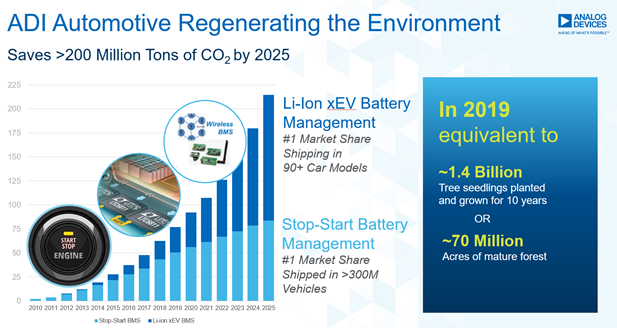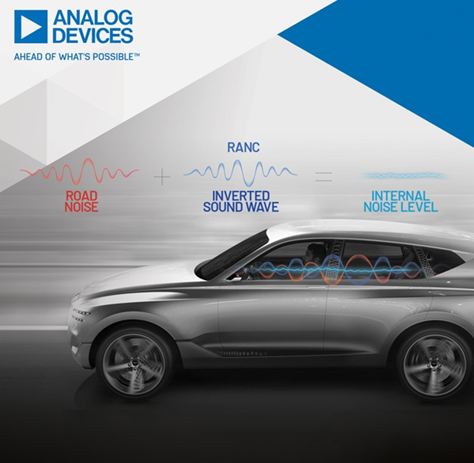The automotive supply chain of decades past no longer exists. New automakers, such as those in Silicon Valley and China, are entering the market with entirely new vehicle architectures and business models to meet the changing needs and demographics of our society. Existing OEMs are sharing vehicle platforms, developing battery packs, selecting battery types, and collaborating with each other to gain economies of scale. As these partnerships form, we see the emergence of regions where local governments coexist with global standards. We are also seeing more and more global alliances to build a sustainable future. Therefore, mobility, rather than cars, is perhaps a better buzzword to reflect the landscape in today’s automotive industry.
The importance of environment
The recent COVID-19 crisis has shown us all how important it is to maintain a healthy environment. Electrification is not only a core technology for our industry, but also a path to sustainable transportation by reducing greenhouse gas emissions from passenger cars, buses, trucks, delivery vans, scooters, etc. Using ADI's advanced technology, it is expected to reduce 200 million tons of CO2 emissions by 2025.

The electric vehicle industry is already a $200 billion-plus industry, with millions of vehicles sold worldwide each year. Each vehicle contains $100 to $3,000 worth of semiconductors, software, and systems. Other elements of the electrification ecosystem, such as charging infrastructure, service models and contracts, fleet management, battery assets, etc., will have a huge impact of trillions of dollars on the global economy.
OEMs around the world have now announced that they will stop developing internal combustion engines and offer all-electric alternatives on every model. Similarly, many retail, transportation and logistics providers have also chosen electric technology. For these reasons, we believe that the electrification revolution is a major shift that will allow us to no longer just maintain the environment, but regenerate it at a healthy and steady rate.
Providing excellent driving range and cabin experience
When it comes to consumer demand for electric vehicles, the vehicle’s range is a primary concern. Since we developed our early products more than a decade ago, our products have been able to provide world-best precision in all conditions, guaranteed for the life of the vehicle, to maximize range and ensure maximum usable battery capacity per charge. Thanks to these advantages, manufacturers of the world’s fastest supercars, such as Rimac, are planning to incorporate ADI’s precise battery management system (BMS) ICs into their products. Rimac is a technology leader in high-performance electric vehicles, focusing on building the world’s fastest supercars, capable of accelerating to 60 mph in under two seconds, with over 1,900 horsepower, and one of the world’s most powerful supercars, where maximum performance and best-in-class range are not just selling points, but essential.
In addition to vehicle range, consumers demand an exceptional in-car experience to enjoy audio and use hands-free devices while driving. Earlier this year, ADI, in collaboration with our key customers, announced a new technology called fully digital Road Noise Cancellation (RNC) that creates a quiet cabin, even for electric vehicles built with lightweight materials. This technology is groundbreaking in the automotive industry and is being introduced by Hyundai Motor Company. The new RNC leverages ADI’s expertise in Automotive Audio Bus (A2B) technology, MEMS accelerometers, and audio DSP processing.
ADI worked closely with Hyundai to design a system that reduces equipment cost, weight, and design complexity, thereby improving overall fuel efficiency. This means that this technology not only benefits the consumer's cabin experience, but also enables vehicle size and weight to be miniaturized to save fuel. So it's also good for the environment without compromising comfort.

Global collaboration
China is the largest electric vehicle manufacturer and has 80% of the world's lithium-ion battery supply. Globally, we see innovation not only from China, but also from Silicon Valley companies, Europe, Japan, South Korea, and Detroit OEMs and all Tier 1 suppliers. Our collaboration in these regions means that ADI will get a big boost as these companies enter the global expansion phase of electric vehicles.
Additionally, global alliances are forming. ADI is an active member of the Global Battery Alliance, which is helping to drive the creation of a sustainable battery value chain by 2030. ADI and 41 other organizations have joined together to agree on battery principles to accelerate a sustainable energy future.
Furthermore, if we view the battery as an asset in a car, our view is that this asset must not only be safe for consumers, but it must also be recyclable and developed using sustainable, environmentally friendly and ethical practices. When we looked at battery chemistries, we found that the lithium iron phosphate (LFP) battery chemistry is made from non-flammable materials and releases oxygen much more slowly under excessive pressure, thereby better preventing thermal runaway and fire. It also contains zero cobalt, which is significant because cobalt is typically mined in an environmentally friendly manner. As electric vehicles become more mainstream, we can expect cobalt to not be accepted by the mainstream. In fact, we have seen many OEMs also declare that they will no longer support cobalt batteries.
What’s Next for ADI?
As the mobile market continues to move toward an electrified future, what can you expect from ADI? Here are our highlights for what’s next:
Expanding our innovation scope to cover the entire lifecycle of a battery, from its formation and testing to its management and the battery’s second lifecycle.
Continue to focus on breakthrough developments in cabin technologies for audio, head unit and driver monitoring to help usher in a future of more comfortable and immersive transportation.
Continue to develop industry-leading sensing and navigation sensing technologies to support the transition from ADAS to fully autonomous driving.
It is committed to influencing policy by joining the World Economic Forum and expanding its business beyond OEMs into high-performance vehicles and into mainstream cars.
The 130-year-old automotive industry is being reimagined, reinvented, and reborn before our eyes. ADI is excited to help drive this transformation and accelerate the future.
Previous article:How Tier 1 Suppliers Can Respond to the Changing Automotive Supply Chain
Next article:Automechanika Shanghai 2020 expands online service channels to help the automotive industry recover
- Popular Resources
- Popular amplifiers
- A new chapter in Great Wall Motors R&D: solid-state battery technology leads the future
- Naxin Micro provides full-scenario GaN driver IC solutions
- Interpreting Huawei’s new solid-state battery patent, will it challenge CATL in 2030?
- Are pure electric/plug-in hybrid vehicles going crazy? A Chinese company has launched the world's first -40℃ dischargeable hybrid battery that is not afraid of cold
- How much do you know about intelligent driving domain control: low-end and mid-end models are accelerating their introduction, with integrated driving and parking solutions accounting for the majority
- Foresight Launches Six Advanced Stereo Sensor Suite to Revolutionize Industrial and Automotive 3D Perception
- OPTIMA launches new ORANGETOP QH6 lithium battery to adapt to extreme temperature conditions
- Allegro MicroSystems Introduces Advanced Magnetic and Inductive Position Sensing Solutions
- TDK launches second generation 6-axis IMU for automotive safety applications
- LED chemical incompatibility test to see which chemicals LEDs can be used with
- Application of ARM9 hardware coprocessor on WinCE embedded motherboard
- What are the key points for selecting rotor flowmeter?
- LM317 high power charger circuit
- A brief analysis of Embest's application and development of embedded medical devices
- Single-phase RC protection circuit
- stm32 PVD programmable voltage monitor
- Introduction and measurement of edge trigger and level trigger of 51 single chip microcomputer
- Improved design of Linux system software shell protection technology
- What to do if the ABB robot protection device stops
- Learn ARM development(15)
- Analysis of the application of several common contact parts in high-voltage connectors of new energy vehicles
- Wiring harness durability test and contact voltage drop test method
- From probes to power supplies, Tektronix is leading the way in comprehensive innovation in power electronics testing
- From probes to power supplies, Tektronix is leading the way in comprehensive innovation in power electronics testing
- Sn-doped CuO nanostructure-based ethanol gas sensor for real-time drunk driving detection in vehicles
- Design considerations for automotive battery wiring harness
- Do you know all the various motors commonly used in automotive electronics?
- What are the functions of the Internet of Vehicles? What are the uses and benefits of the Internet of Vehicles?
- Power Inverter - A critical safety system for electric vehicles
- Starting from the end of this year, you will not be able to buy 2G data cards
- [Artry AT32F421 Review] Power Supply --- Settings
- Domestic chip replacement is the general trend! Take the topic of "replacement and why to replace" of ST chips, welcome everyone to speak...
- 【ST NUCLEO-H743ZI Review】(2) First experience with Ethernet testing
- What is TV_RM? What is its function?
- [TI Course] Is there any problem with Figure 4.3.2 of 4.3.1 Differential Amplifier?
- [Lazy self-care fish tank control system] Production of BLE_MESH fish tank light
- MATLAB R2020a Complete Self-Study Guide
- Buy an oscilloscope and get the essential analysis software 5-PWR for power engineers
- Why is there no output on PC14 of GD32F107VCT6 as IO port?

 AD8682ARMZ-REEL
AD8682ARMZ-REEL
















 京公网安备 11010802033920号
京公网安备 11010802033920号